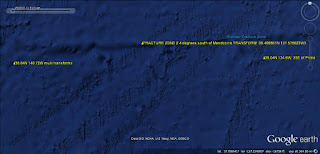Hurricane is a name given to the strong winds from the north caused by downslope gusts- created by air mass from the north (same as Hf moving (CCW at the Colorado Plateau, Cp); original settler with covered wagon top blown off exclaimed "that was a Hurkin" Isaac below:
Hurricane Mesa is the plateau on the Cp to the east- toward Virgin Town and Zion NP:
North are the 2 million years or less Virgin Anticline, Pine Valley Mountains PVM of 22 m.y., and the Virgin River as a divider:
Diagonal line of the anticline lies above Quail Lake (center dark water) and below PVM:
Climbing Hf is the Honeymoon Trail, a road from Arizona to the St. George Temple for 19th century marriages- which is passable for 4W drives:
I have taken portions of Hf to find the Ratio of Arc distances on GE, and the first trial at Hurricane city was 2.54 for an equivalent 2.49 Inclination degrees Ratio of the largest for Saturn- with an orbit of 29 years. I have witnessed 3 killer rockfalls during that time- indicating the Activity for the nearby area.
Basin and Range is west, and Cp is to East- showing the maintained Honeymoon Trail:
Google Earth GE coordinates of the Honeymoon trail Ht- climbing the Hf scarp:Heat from the scraping of Cp with Hf creates springs- named Pah Tempe below:
View of Ht from above the Hurricane fault Hf shows the scarp contrast above BaR, with PVM to the west:
Checkerboard 2 is found in the Virgin Canyon, below the oldest Watertower Crater, Hurricane town, and reveals slickensides in a figure 8 pattern for basalt outcrops, fan-shaped patterns, and angles:
Larger view, near Virgin River, with basalt eroded boulders at edge:
Contact between Mesozoic sediments and Pleistocene extrusives:
Checkerboard 2 orthogonal Fan closeup, for angles, spirals,and the divider:
Details of the Checkerboard surroundings:
Checkerboard wall shift shows the basalt above the Virgin River creating rotation:
Checkerboard Reversal created by cooling with a Reverse "S" CW, after rising CCW:
Large view of the Virgin and Basalt slicks, where an Inflection has created the rotation:
Atop Cp is another larger Checkerboard Mesa- which divulges information about Dynamics:
Elliptical shape is seen on the south side below, and the Location from GE:
Expanded Mesa from above shows the reversing Terraces- which have formed after Erosion has removed the surroundings (making an uplift by comparison with removed rock) below:
Now- volcanodiscovery.com in the Hurricane, Utah area;
Sullivan Knoll, above, is the closest and youngest Pleistocene extrusion- roughly 1/4th of the age of the million year Ivin Knoll to the south of it:
Ivin Knoll above and below is mostly eroded, and is the same age as the flow at the AZ border: the highest elevation at the divider:
Divide extrusion occurs across the Hurricane fault Hf, and is split by the uplift:
Highest elevation- indicating uplift from below- is shown on the south road to Arizona from Hurricane town:
Divide basalt flow is shown spilling over Hf:
Larger view of the basalt flow and its flow to the west, 10 miles south of Hurricane:
A Crater inside the Hurricane city limits is Red Ash- previously mined for road metal:
Across the Virgin River from Hurricane town is the Leeds crater- a dormant discolored plug, which will restart soon; it is the Focus of the rotation of the Virgin anticline, producing heat from the scraping of Red Mountain (center right, by the yellow diagonal):
Buildup to a new eruption is the 70F boiler on the Washington City fault- 20 km to the west of Hf; it isused to warm hothouses near I-15 Freeway:
Crater Hill on Cp is one that has erupted twice; spent, and covering gravels allowing spring flow on the Virgin City road gully:
Spring location is shown below the outlying lava flow:
Craters within the Hurricane City limits include the Water tower, Red ash, and Sullivan knoll- where the LaGrange equilateral triangle ET was measured. 8 craters above and below Hf make an ellipse pattern- indicating that some preceded Hf:
Enlarged for City limits Triangulation of the Heat production of LaGrange:
Hf large Virgin canyon view, for exploring the anomalies at the Pah Tempe hot springs, SO2. and the intersection distance to Hf:
Hf at the Pah Tempe hot spring coordinates:
Hf slickensides at Hiway 9 show there are 4 down moves for 1 lateral rotation CCW:
Sunlight shows the nearby slicks to be shiney for, information on movement; these terminate the ones found on the Hurricane fault Hf to the south:
Slickensides with ice in the sunlight, last to the south at Hf (obscured to south by rubble, and incomplete):
earthquake.usgs.gov






























































































